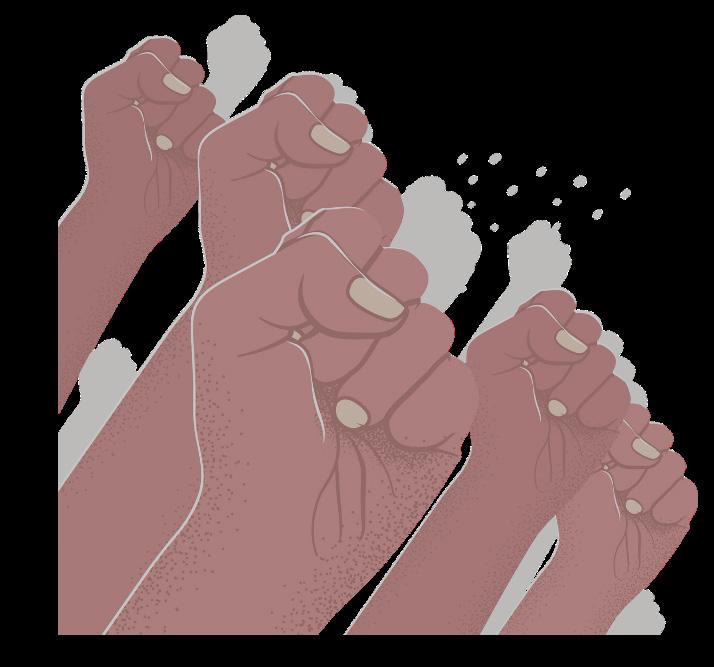
5 minute read
WHAT HAPPENS WHEN NEWS AWAYLOOKS
Even When The News Looks Away The Story Does Not Die Alongside It
TThe freedom of the press is a longstanding value of the country. The digital age has allowed more people to experience the creation and spread of information and has been widely accessible.
Advertisement
Hot topic issues can gain much needed momentum through a spike in media coverage. However, more relevant problems can take precedent, leaving long term issues behind. What happens when the news looks away from these ongoing stories?
Demonstrations for LGBTQ+ human rights have existed for many decades, with one of the most wellknown protests being the Stonewall Uprising in 1969, a series of riots caused after police raided the Stonewall Inn. It was one of the first times in history where LGBTQ+ people fought back against their discrimination and showed pride in who they were. A year later in 1970, to remember Stonewall’s impact, the first pride parades were held. However, it took another 33 years for Massachusetts to be the first state to legalize same-sex marriage in 2003.
Even after legalization, married same-sex couples did not always qualify for the same marriage benefits as opposite-sex marriages until the United States v. Windsor decision in 2013.
Last year, the rights and recognition of same sex couples was considered for review by Supreme Court Justice Clarence Thomas. Anti-LGBTQ+ hate crimes have continued since last Dec., such as Club Q, a LGBTQ+ nightclub in Colorado, was the target of a mass shooting where five people lost their lives and 19 others were injured.
One other social movement from recent years was the boycotting of Disney’s live-action Mulan, which was released in 2020. Mulan was partially filmed in the Xinjiang region of China in Aug. 2018. While it may seem insignificant, in 2017 personal testimonies came out about Muslim “re-education” camps in that region. These camps detained a total of roughly 1.8 million Muslims as of 2020 with the goal of “fighting terrorism” according to the Chinese authorities.
However, there have been accounts of beatings and deprivation of essentials such as food, water, and sleep.
This controversy gained attention during the initial release of the liveaction Mulan, but the issue has disappeared from mainstream media, despite the continuation of the camps and the denial of their existence entirely.
Another movement that is longstanding is climate change advocacy. In the last decade, it has picked up momentum due to one of the most vocal activists, the now 20-year-old Greta Thunberg.
Thunberg uses a variety of demonstrations to prove her and her fellow activists’ point. From publicly criticizing governments, companies, and world leaders’ lack of climate action on social media to being detained after protesting at a German coal mine just last month, she has led the charge. Just five years ago, in Aug. of 2018, the then 15-year-old began what would become a global movement.
Thunberg encouraged fellow students to follow her in a school strike each Friday, creating the slogan #FridaysForFuture. The protests became widely publicized, creating large amounts of supporters and critics. No matter the viewpoint, news outlets flocked to Thunberg, creating an aura of media attention around climate change. The thousands of students protesting in the streets would have brought awareness, but it was the media coverage that took the movement to a global level.
“We, above all, need [climate goals] for 2021 and every following month and year to come,” Thunberg said at a 2021 protest in Glasgow.
There is no question that climate change is a pressing issue, but its slow progression has hindered its ability to constantly appear in the media. Without pressing new developments, the media looked away.
A similar hashtag sprung up around the same time as well. In 2006, sexual assault survivor and activist Tarana Burke started the #MeToo movement to support victims and survivors of sexual assault. The hashtag exploded in 2017 and was seen everywhere— from social media posts to magazine covers, Burke provided a voice to those who were not heard.
It began to gain traction when actress Alyssa Milano tweeted ‘#MeToo’ and within 24 hours, there were 12 million responses on social media. Voices that were quiet for years came resonating throughout the world, resulting in repercussions for those found responsible.
People such as Harvey Weinstein, a director who was accused of sexual misconduct from over a dozen women, were put in the spotlight and faced repercussions.
Currently, Burke focuses on helping a wide spectrum of survivors, aiding them in finding their own unique journey to healing. Simultaneously, the MeToo organization is working to disrupt the systems that allow sexual violence to harm communities.

Burke is continuing to work towards to route of the problem, saying that “There has to be a shift in culture.”
However, sexual assault remains to be one the most under reported violent crimes, according to the Bureau of Justice, with only around 20-30 percent of cases being reported each year.
In a similar fashion to the #MeToo movement, what started in 2013 as the social media trend #BlackLivesMatter grew into a globally known campaign. According to the Black Lives Matter website, they were founded on the mission of “investing in the future of Black.”
Though it grew over the next few years, it was not until the death of George Floyd on May 25, 2020, that the movement gained worldwide traction and news coverage. Following Floyd’s death, the Washington Post reported that, “developments of recent [events] show how the movement has embedded in the mainstream in ways that would have been unthinkable just a few years ago.”
Throughout 2020 and into 2021, the media dove straight into covering the subject. Headlines relating to Black Lives Matter appeared daily, and the discussion of race in America was being brought back to the table.
A national poll conducted by Civiqs, a non-partisan polling service, showed 52 percent support for Black Lives Matter at the height of its media coverage in mid-2020.
As news coverage declined across the following two years, the same poll reported 41 percent support at the start of this year. Despite the drop in popularity, the organization has pushed What on in its efforts to support the African American community.
On Sept. 20, 2022, Black Lives Matter Global Network Foundation re-launched its voter registration website to shrink the racial gap among voters. United States Census Bureau’s report on the 2022 midterm election found that 64 percent of African Americans registered to vote, an increase from the 59 percent in 2018.
The drop in coverage was not a deliberate scheme on the part of media platforms, simply a choice to cover the most relevant subject. As global safety issues like the pandemic picked up rapid daily coverage, the space for social movements became sparce.
The media has a responsibility to provide its readers with the most relevant and timely information. The fast-paced nature of modern society coupled with limited resources creates a situation where certain stories are forced to be put on the back burner. Even when the news looks away, the story does not die alongside it. Story by Erin Lock, Madelynn Page and Maya Patel.
What do you think is the responsibility of the media?
“I think the purpose of media, especially in schools, is not only to educate the students about whats going on but also to englightent them about other topics they don’t know about.”
-Amber Liwanag, 9

“The role of the media is to give people unbiased information.”
-Hannah Davis, 10









